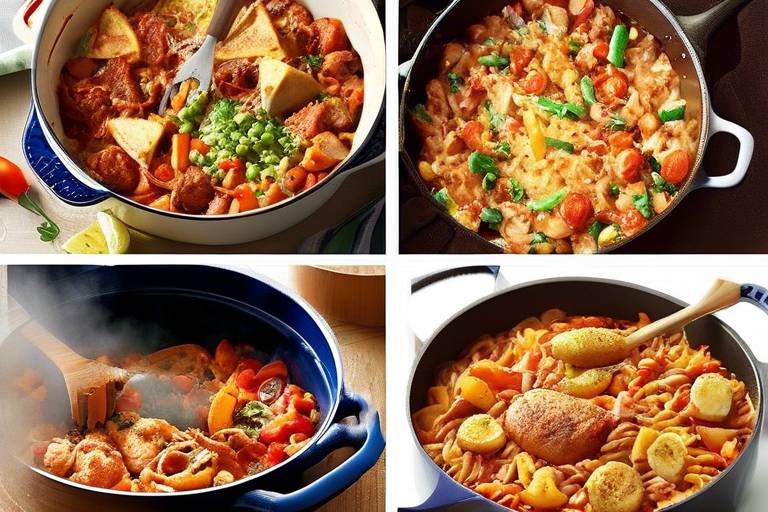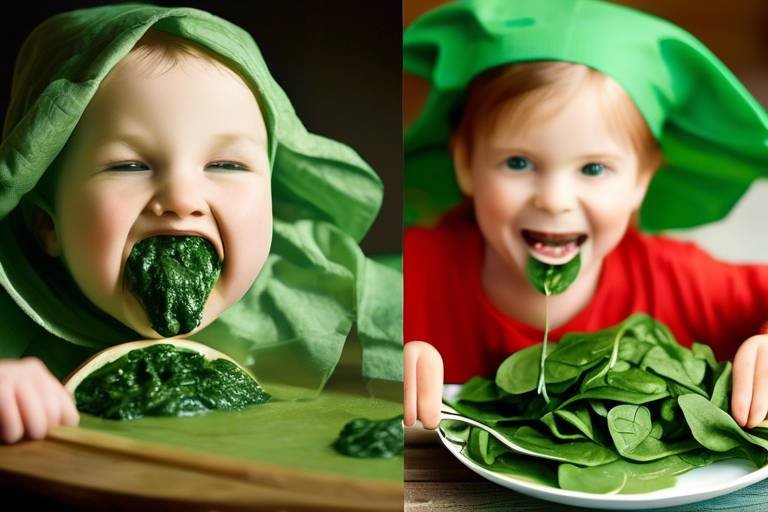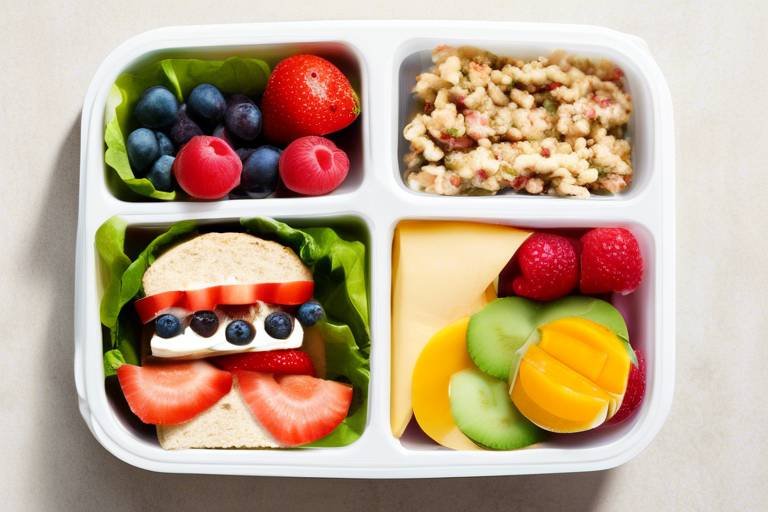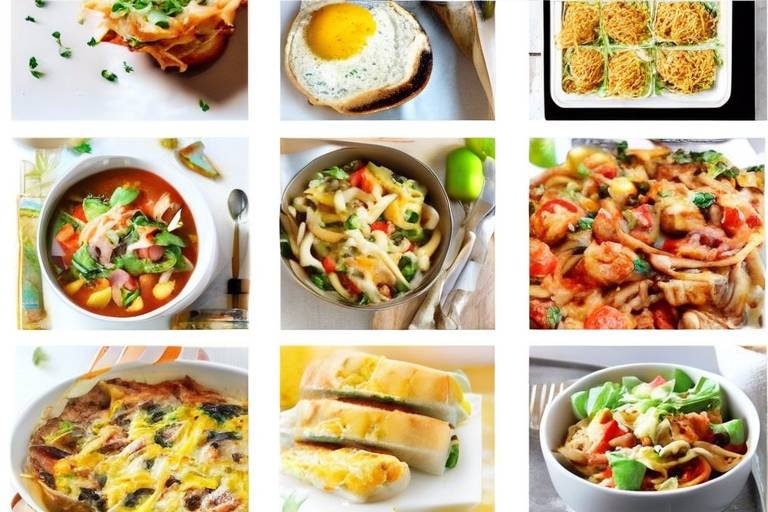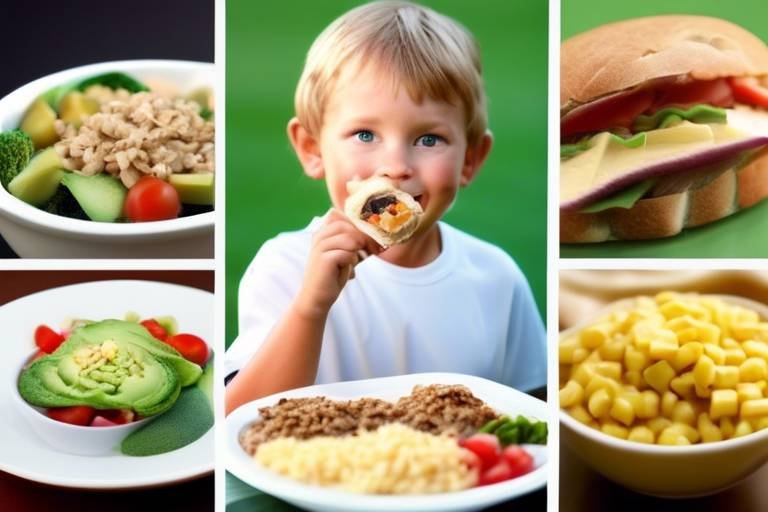Cooking with Kids: Healthy Recipes They Can Make
Cooking with kids is not just about preparing meals; it's an adventure that opens up a world of creativity, learning, and fun! When you invite your little ones into the kitchen, you're not just teaching them how to cook; you're also nurturing their imagination and independence. Imagine the joy on their faces when they create their first dish or mix ingredients to make a delightful smoothie! It's these moments that foster a love for nutritious eating while equipping them with essential life skills.
In today’s fast-paced world, it’s easy to overlook the importance of cooking together. However, when children participate in meal preparation, they gain a better understanding of what goes into their food. This hands-on experience promotes healthy eating habits and encourages kids to make better food choices. Plus, it’s a fantastic way to spend quality time together as a family, strengthening those precious bonds.
So, what are some of the fun and healthy recipes that kids can whip up? From vibrant breakfast smoothies to creative lunch wraps, the possibilities are endless! Each recipe not only tantalizes their taste buds but also teaches them valuable skills like measuring, mixing, and even basic food safety. As they embark on this culinary journey, you’ll be amazed at how their confidence grows with each dish they create.
Let’s dive into some simple recipes that are perfect for little chefs, starting with breakfast. After all, it’s the most important meal of the day, and what better way to kick off the morning than with a nutritious meal that kids helped to make? Get ready to explore some delightful options that will have your children excited to jump into the kitchen!

Benefits of Cooking with Kids
Engaging children in cooking activities is not just about making meals; it's a fantastic way to enhance their understanding of nutrition, build confidence, and strengthen family bonds. When kids step into the kitchen, they embark on a journey filled with creativity and learning. Think of it as a mini-adventure where they can explore new flavors and textures while developing essential life skills. Plus, cooking together creates lasting memories that families cherish.
One of the primary benefits of cooking with kids is the opportunity to teach them about healthy eating habits. By involving them in meal preparation, you can explain the nutritional value of different foods. For instance, you can discuss how fruits provide vitamins and minerals essential for growth. This knowledge empowers children to make informed food choices, which can lead to healthier lifestyles as they grow. It’s like giving them the keys to a treasure chest of health!
Moreover, cooking together fosters a sense of accomplishment in children. When they successfully create a dish, it boosts their self-esteem and encourages them to try new things. Imagine the pride they feel when they serve a meal they prepared themselves! This newfound confidence can spill over into other areas of their lives, inspiring them to take on challenges with a positive attitude.
Family bonding is another significant advantage of cooking together. It's a chance to disconnect from screens and engage in meaningful conversations. As you chop vegetables or stir sauces, you can share stories, laugh, and enjoy each other's company. This quality time strengthens relationships and creates a supportive environment where kids feel valued and heard.
Additionally, cooking can be a fantastic way to introduce basic math and science concepts. Measuring ingredients, timing cooking processes, and understanding how different elements interact in recipes can make learning fun and practical. For example, when kids measure flour or count the number of apples needed for a pie, they are unknowingly practicing math skills. It’s like sneaking vegetables into a delicious dish—educational and enjoyable!
In summary, the benefits of cooking with kids extend far beyond the kitchen. It nurtures their creativity, promotes healthy eating, builds confidence, fosters family connections, and enhances learning. Each time you cook together, you’re not just preparing a meal; you’re crafting a foundation for a healthier, happier future.

Simple Breakfast Recipes
Starting the day with a nutritious breakfast is crucial for children’s growth and energy levels. What better way to ensure they eat healthily than by involving them in the cooking process? Simple breakfast recipes not only provide essential nutrients but also engage kids in a fun and interactive way. Imagine the joy on their faces as they create their own meals! This is where we dive into some easy and delicious breakfast ideas that your little chefs can whip up with a little guidance.
Making fruit smoothies is not just a tasty experience; it's a fantastic way for kids to explore different flavors and textures. They get to choose their favorite fruits, which can range from bananas to berries, and blend them into a delightful drink. The best part? They can experiment! Want to throw in some spinach for an extra health kick? Go for it! It’s all about creativity in the kitchen.
When it comes to smoothies, the options are endless. Here’s a quick table of common ingredients that kids can mix and match:
| Fruits | Dairy/Non-Dairy | Add-Ins |
|---|---|---|
| Banana | Yogurt | Honey |
| Strawberries | Almond Milk | Chia Seeds |
| Mango | Coconut Milk | Peanut Butter |
| Spinach | Greek Yogurt | Oats |
Encouraging kids to select their ingredients not only promotes healthy choices but also gives them a sense of ownership over their meal. It’s like being a mini chef, crafting their own unique recipes!
Now, let’s talk about the fun part—using the blender! Teaching kids how to use a blender safely is essential. Start by explaining the importance of keeping their fingers away from the blades and ensuring the lid is on tight. Then, show them how to blend their ingredients effectively. A good tip is to layer the ingredients: liquids first, then soft fruits, followed by harder fruits or ice. This technique helps achieve a smooth consistency without any lumps. Plus, blending is a great way to develop their motor skills!
If your kids are not morning people, overnight oats might just become their new best friend. This simple, no-cook breakfast option allows kids to prepare their meal the night before, which means less stress in the morning. All they need is a jar, some oats, and their favorite toppings. They can mix oats with milk or yogurt and let it sit overnight. In the morning, they can add whatever toppings they like—fruits, nuts, or even a sprinkle of chocolate chips for a treat!
Imagine this: your child opens the fridge to find a delicious jar of overnight oats waiting for them. They can customize it each time, making it a fun breakfast ritual. It's like a surprise in a jar!

Fruit Smoothies
Making is not just a delightful activity for kids; it's also a fantastic way for them to explore a world of flavors and textures. Imagine your little ones standing in the kitchen, selecting vibrant fruits from the countertop, their eyes lighting up with excitement as they choose their favorites. Whether it’s ripe bananas, juicy strawberries, or refreshing spinach, the options are endless! Plus, this fun process encourages them to make healthy choices while learning about the nutritional benefits of each ingredient.
To get started, gather a variety of fruits and some basic ingredients. Here’s a quick list of popular choices that kids can mix and match:
- Bananas
- Strawberries
- Blueberries
- Mangoes
- Spinach
- Yogurt
- Milk or juice
Once they’ve selected their fruits, it’s time to blend! Teaching kids how to use a blender safely is an essential skill. Show them how to secure the lid properly and start with low speeds before gradually increasing to achieve that perfect consistency. It’s like watching a magic show unfold right in your kitchen as they blend their unique concoctions. And don’t forget to remind them to taste their creation before serving—after all, a little quality control never hurt anyone!
Encouraging kids to experiment with different ingredients can lead to some surprising and delicious results. For instance, they might discover that adding a splash of orange juice gives a zesty kick to their smoothie or that a spoonful of honey sweetens the deal perfectly. This process not only enhances their culinary skills but also boosts their confidence as they see the delicious results of their hard work.
Incorporating smoothies into their breakfast routine can also set a positive tone for the day. They are not only quick to make but also packed with vitamins and minerals that will energize your little ones for their daily adventures. So, next time you’re looking for a fun and healthy breakfast option, grab those fruits and let your kids take the lead in creating their own . It’s a delicious way to start the day—and who knows, you might just find a new family favorite!
Q: Can I add vegetables to smoothies?
A: Absolutely! Spinach, kale, and even carrots can be blended into smoothies without altering the taste too much, making them a great way to sneak in some extra nutrients.
Q: How can I make smoothies without added sugar?
A: Use naturally sweet fruits like bananas and mangoes to sweeten your smoothies. You can also add a bit of honey or maple syrup if needed, but often the fruits provide enough sweetness on their own.
Q: What’s the best way to store leftover smoothies?
A: If you have leftover smoothie, pour it into an airtight container and refrigerate it. It’s best consumed within 24 hours for optimal freshness, but you can also freeze it in ice cube trays for later use!

Ingredients to Use
This article explores fun and healthy recipes that children can easily prepare, fostering their creativity and teaching them valuable cooking skills while promoting nutritious eating habits.
Engaging children in cooking activities enhances their understanding of nutrition, builds confidence, and strengthens family bonds. Discover the numerous advantages of involving kids in the kitchen.
Start the day right with easy breakfast recipes that kids can help prepare. These nutritious options will energize your little ones and encourage healthy morning routines.
Making fruit smoothies is a fun way for kids to experiment with flavors and textures. They can choose their favorite fruits and blend them for a delicious, healthy treat.
When it comes to crafting the perfect smoothie, the options are virtually endless! Start with a base of yogurt or milk, which not only adds creaminess but also packs in protein. Next, let your kids pick from a colorful array of fruits:
- Bananas - Great for sweetness and a creamy texture.
- Berries - Packed with antioxidants and deliciously tart.
- Mango - Adds a tropical flair and vibrant color.
- Spinach or Kale - Sneak in some greens without sacrificing flavor.
Additionally, you can add nut butters or seeds for a boost of healthy fats and protein. Tell your kids to think outside the box! They can mix in ingredients like oats for fiber or a splash of honey for extra sweetness. The key is to encourage them to explore and find combinations they love, turning smoothie-making into a fun and nutritious adventure.
Teach kids how to use a blender safely and effectively. Understanding blending techniques will empower them to create their own smoothie recipes.
Overnight oats are a simple, no-cook breakfast option that kids can prepare the night before. They can customize their oats with toppings and flavors they enjoy.
Explore creative and healthy lunch ideas that kids can assemble themselves, making lunchtime both nutritious and enjoyable. These recipes encourage independence and creativity in meal preparation.
Kids can create their own wraps and rolls using various ingredients. This hands-on activity allows them to explore different flavors while making a balanced meal.
Creating homemade Lunchables is a fun way for kids to assemble their favorite snacks. They can mix and match ingredients for a nutritious, personalized lunch experience.
Q: What age is suitable for kids to start cooking?
A: Kids can start helping in the kitchen as early as 2-3 years old with simple tasks like washing vegetables or stirring. As they grow older, they can take on more complex tasks.
Q: How can I ensure the recipes are healthy?
A: Focus on whole ingredients like fruits, vegetables, whole grains, and lean proteins. Encourage kids to choose their ingredients and explain the benefits of each.
Q: What if my child is a picky eater?
A: Involve them in the cooking process! Let them choose ingredients and prepare meals; this can spark their interest in trying new foods.

Blending Techniques
This article explores fun and healthy recipes that children can easily prepare, fostering their creativity and teaching them valuable cooking skills while promoting nutritious eating habits.
Engaging children in cooking activities enhances their understanding of nutrition, builds confidence, and strengthens family bonds. Discover the numerous advantages of involving kids in the kitchen.
Start the day right with easy breakfast recipes that kids can help prepare. These nutritious options will energize your little ones and encourage healthy morning routines.
Making fruit smoothies is a fun way for kids to experiment with flavors and textures. They can choose their favorite fruits and blend them for a delicious, healthy treat.
Learn about various fruits, yogurt, and other nutritious ingredients that can be used to create tasty smoothies. Encouraging kids to select ingredients promotes healthy choices.
When it comes to blending smoothies, there are a few essential techniques that can make the process both fun and effective for kids. First and foremost, it’s important to teach them about safety. Always ensure that they understand to keep their hands and utensils away from the blades while the blender is in operation. A quick demonstration by an adult can help reinforce this safety rule.
Next, show them how to layer their ingredients correctly. Start with liquids at the bottom, followed by soft fruits, and then harder ingredients like ice or frozen fruit on top. This technique helps the blender work more efficiently and ensures a smoother blend. Kids will love the idea of creating their own smoothie masterpieces!
Additionally, encourage them to experiment with different blending speeds. Start on a low setting to combine the ingredients, and then gradually increase the speed for a smoother texture. This not only gives them control over the consistency of their smoothie but also teaches them about the mechanics of how a blender works.
Finally, it’s all about creativity! Encourage your little chefs to try out various combinations of fruits, vegetables, and even add-ins like spinach or protein powder. This experimentation can lead to delightful surprises, and who knows, they might just invent the next big smoothie trend!
Overnight oats are a simple, no-cook breakfast option that kids can prepare the night before. They can customize their oats with toppings and flavors they enjoy.
Explore creative and healthy lunch ideas that kids can assemble themselves, making lunchtime both nutritious and enjoyable. These recipes encourage independence and creativity in meal preparation.
Kids can create their own wraps and rolls using various ingredients. This hands-on activity allows them to explore different flavors while making a balanced meal.
Creating homemade Lunchables is a fun way for kids to assemble their favorite snacks. They can mix and match ingredients for a nutritious, personalized lunch experience.
Q: At what age can my child start cooking?
A: Children as young as 3 can start helping in the kitchen with simple tasks, while older kids can take on more complex recipes.
Q: What are some safe kitchen tools for kids?
A: Child-safe knives, plastic measuring cups, and non-slip cutting boards are great tools for kids to use while cooking.
Q: How can I make cooking more fun for my kids?
A: Incorporate games, let them choose recipes, and celebrate their culinary creations to make cooking enjoyable.

Overnight Oats
Overnight oats are not just a trendy breakfast option; they are a simple, no-cook solution that kids can prepare the night before. Imagine waking up to a delicious and nutritious meal that your little ones made themselves! This hands-on activity not only teaches them valuable cooking skills but also allows them to express their creativity in the kitchen. The beauty of overnight oats lies in their customizability. Children can choose their favorite flavors, toppings, and ingredients, making breakfast a fun and personalized experience.
To make overnight oats, all you need is a few basic ingredients: rolled oats, milk (or a dairy-free alternative), and a container to mix everything in. The process is incredibly straightforward. Kids can combine these ingredients in a jar or bowl, stir them up, and let them sit in the refrigerator overnight. By morning, the oats will have absorbed the liquid, creating a creamy and satisfying dish. This is a fantastic way to teach kids about meal prep and the importance of planning ahead.
When it comes to flavors, the possibilities are endless! Here are some ideas to inspire your little chefs:
- Fruity Delight: Add chopped fruits like bananas, strawberries, or blueberries.
- Nutty Flavor: Include a spoonful of peanut butter or almond butter for a protein boost.
- Sweet Treat: Drizzle some honey or maple syrup for natural sweetness.
- Spice it Up: Sprinkle some cinnamon or vanilla extract for an extra flavor kick.
Teaching kids how to prepare overnight oats also provides a great opportunity to discuss nutrition. You can explain how oats are a good source of fiber and can keep them feeling full throughout the morning. Additionally, by letting them choose their toppings, you encourage healthy eating habits that can last a lifetime. Whether they prefer a fruity explosion or a nutty twist, kids will love creating their own breakfast masterpiece!
Finally, to make the process even more engaging, consider setting up a "toppings bar" in your kitchen. You can lay out various ingredients like fruits, nuts, seeds, and sweeteners, allowing kids to explore and mix their favorite combinations. This not only makes breakfast preparation fun but also fosters a sense of independence and ownership over their meals. So, why not turn breakfast into a delightful family activity? With overnight oats, every morning can be a new adventure!

Fun Lunch Ideas
When it comes to lunchtime, kids often crave something exciting and tasty, but as parents, we want to ensure that what they eat is also healthy. That's where come into play! By encouraging children to assemble their own meals, they not only enjoy the process but also learn valuable skills. Imagine your little chef rolling up their sleeves, diving into a world of flavors, and creating their own masterpieces. How cool is that?
One fantastic option is to let kids create their own wraps and rolls. This hands-on activity allows them to pick from a variety of ingredients, making each meal unique and personal. Just think about the combinations! They can choose from whole-wheat tortillas, lettuce leaves, or even rice paper. For fillings, the sky's the limit: grilled chicken, turkey slices, hummus, cheese, and an array of veggies like bell peppers, cucumbers, and carrots. The best part? Kids can experiment with different flavors and textures while learning about balanced nutrition.
Another exciting idea is to make DIY Lunchables. Remember those pre-packaged Lunchables? Kids love them, but homemade versions are not only healthier but also a lot more fun! Start by providing a selection of crackers, cheese slices, and deli meats. Add in some colorful fruits and veggies, like cherry tomatoes, cucumber slices, or apple wedges. You can even throw in a small treat like dark chocolate or yogurt-covered raisins. The beauty of DIY Lunchables is that children can mix and match their favorite ingredients, creating a lunch that’s both nutritious and delicious!
Here’s a quick comparison table to illustrate the differences between store-bought Lunchables and homemade versions:
| Feature | Store-Bought Lunchables | Homemade Lunchables |
|---|---|---|
| Nutrition | Often high in sodium and preservatives | Customizable with fresh ingredients |
| Cost | Can be expensive over time | More cost-effective, especially in bulk |
| Fun Factor | Limited choices | Unlimited creativity and combinations |
Involving kids in the kitchen not only makes lunchtime more enjoyable but also fosters a sense of independence and creativity. They learn to make decisions about what they want to eat, which can lead to healthier habits in the long run. Plus, it’s a wonderful opportunity for parents to bond with their children over food preparation. So, why not gather some ingredients and let your kids get creative? You might be surprised at what they come up with!
- What age can kids start cooking? Kids as young as 3 can help in the kitchen with supervision, while older children can take on more complex tasks.
- Are there any safety tips for kids in the kitchen? Always supervise them, teach them about knife safety, and ensure they understand how to use appliances properly.
- How can I encourage picky eaters to try new foods? Involve them in the cooking process, let them choose ingredients, and present food in fun and creative ways.

Wraps and Rolls
Wraps and rolls are not just delicious; they’re a canvas for creativity! Kids can dive into the world of flavors and textures, assembling their own meals with a variety of ingredients. Imagine a colorful spread of vegetables, proteins, and sauces laid out on the kitchen counter, just waiting for little hands to create something spectacular. This activity not only makes lunchtime fun but also encourages children to take charge of their meals, promoting independence in the kitchen.
To get started, you can provide a selection of ingredients that appeal to your kids. Here’s a simple framework for assembling wraps and rolls:
| Base | Fillings | Sauces |
|---|---|---|
| Tortillas | Grilled chicken, turkey, or tofu | Hummus, ranch, or salsa |
| Rice paper | Fresh veggies (cucumbers, bell peppers, carrots) | Peanut sauce or soy sauce |
| Flatbreads | Cheese, spinach, or beans | Yogurt or tzatziki |
By allowing kids to choose their base, fillings, and sauces, you’re not just giving them a meal; you’re giving them a chance to express their tastes and preferences. This hands-on experience can spark discussions about nutrition, as they learn which ingredients are more beneficial for their bodies. For instance, you might explain how proteins help build muscles while vegetables provide essential vitamins and minerals.
Encouraging creativity is key. Challenge your kids to come up with their own unique combinations! Perhaps they’ll discover that a tortilla filled with turkey, spinach, and a drizzle of ranch is their new favorite, or maybe they’ll surprise you with a rice paper roll bursting with colorful veggies and a sweet peanut sauce. The possibilities are endless!
Additionally, wraps and rolls can be a fantastic way to use up leftovers from previous meals. Have some grilled chicken from last night’s dinner? Toss it into a wrap with some fresh greens and a bit of cheese. Not only does this minimize food waste, but it also teaches kids the importance of being resourceful in the kitchen.
Lastly, don’t forget to make it fun! Set up a “wrap bar” where kids can assemble their meals at their own pace. Play some upbeat music, and turn the kitchen into a lively space. This not only makes cooking enjoyable but also creates lasting memories. After all, the kitchen is often the heart of the home!
Q1: What types of wraps are best for kids?
A1: Whole grain tortillas, flatbreads, and rice paper are all great options. They provide a nutritious base and are easy for kids to handle.
Q2: Can wraps be made ahead of time?
A2: Yes! You can prepare wraps in advance, but it's best to keep sauces separate until ready to eat to avoid sogginess.
Q3: How can I encourage my kids to try new ingredients?
A3: Involve them in the selection process and make it a fun challenge to create a wrap with at least one new ingredient each time.

DIY Lunchables
Creating your own is not just a fun activity; it's a fantastic way for kids to express their creativity while enjoying a nutritious meal. Who wouldn’t want to assemble their own lunch? This hands-on approach allows children to mix and match their favorite ingredients, making lunchtime both exciting and healthy. Plus, they can take ownership of their meal, which is a great confidence booster!
To get started, consider setting up a little assembly line in your kitchen. Gather a variety of ingredients and let your kids choose what they want to include in their DIY Lunchables. Not only does this encourage healthy eating habits, but it also teaches them about portion control and balanced meals. Here’s a quick breakdown of what you might include:
| Category | Options |
|---|---|
| Proteins | Turkey slices, cheese cubes, hummus, hard-boiled eggs |
| Carbs | Whole grain crackers, pita bread, mini bagels |
| Fruits | Apple slices, grapes, berries, dried fruits |
| Veggies | Carrot sticks, cucumber slices, cherry tomatoes |
| Dips | Ranch dressing, guacamole, yogurt dip |
Once you have all your ingredients laid out, let the kids go wild! They can create their own combinations, like turkey and cheese on whole grain crackers, paired with apple slices and a side of hummus for dipping. The possibilities are endless, making it a delightful experience that keeps lunchtime fresh and exciting.
Moreover, this activity can also serve as a lesson in nutrition. Talk to your kids about the importance of including different food groups in their meals. Ask them questions like, “What protein do you want to include?” or “Which fruits do you think will taste best with your lunch?” This not only engages them but also fosters a sense of responsibility for their food choices.
So, roll up your sleeves and get ready for a lunchtime adventure! With DIY Lunchables, your kids won’t just be eating; they’ll be creating, learning, and enjoying every bite. It’s a fun way to make healthy eating a part of their daily routine!
Q: Can I prepare DIY Lunchables the night before?
A: Absolutely! You can prep ingredients in advance and let your kids assemble their Lunchables in the morning. Just make sure to store perishable items in the fridge.
Q: What if my child is a picky eater?
A: Encourage them to try new things by introducing one new ingredient at a time. You can also let them pick their favorites from a selection of healthy options.
Q: Are DIY Lunchables cost-effective?
A: Yes! Making your own Lunchables is often cheaper than buying pre-packaged ones. Plus, you have control over the quality and nutritional value of the ingredients.
Q: How can I make it more fun?
A: Consider using cookie cutters to create fun shapes with veggies or sandwiches. You can also theme your Lunchables around holidays or favorite characters to spark their interest!
Frequently Asked Questions
-
What are the benefits of cooking with kids?
Cooking with kids is not just about making food; it's a fantastic way to teach them about nutrition, build their confidence, and strengthen family bonds. When children help in the kitchen, they learn essential life skills and develop a sense of independence. Plus, it’s a great opportunity for quality time together!
-
What are some easy breakfast recipes for kids?
Some simple breakfast recipes include fruit smoothies and overnight oats. Kids can choose their favorite fruits for smoothies, making it a fun and colorful experience. Overnight oats can be customized with various toppings, allowing children to get creative while enjoying a nutritious start to their day.
-
How can I make cooking safe for my kids?
Safety is key when cooking with kids! Start by teaching them about kitchen safety, like how to handle knives and use appliances like blenders. Always supervise them closely, especially when they're using heat or sharp tools. Setting clear rules and guidelines will help keep everyone safe while having fun!
-
What are DIY Lunchables, and how can kids make them?
DIY Lunchables are a fun and healthy twist on the store-bought version! Kids can assemble their own lunch by choosing a variety of ingredients like whole grain crackers, cheese slices, and veggies. This hands-on activity allows them to mix and match their favorite foods, making lunchtime both nutritious and enjoyable.
-
Can cooking with kids help them make healthier food choices?
Absolutely! When kids are involved in the cooking process, they become more aware of what goes into their meals. By allowing them to choose and prepare healthy ingredients, you’re empowering them to make better food choices and develop a positive relationship with food.






